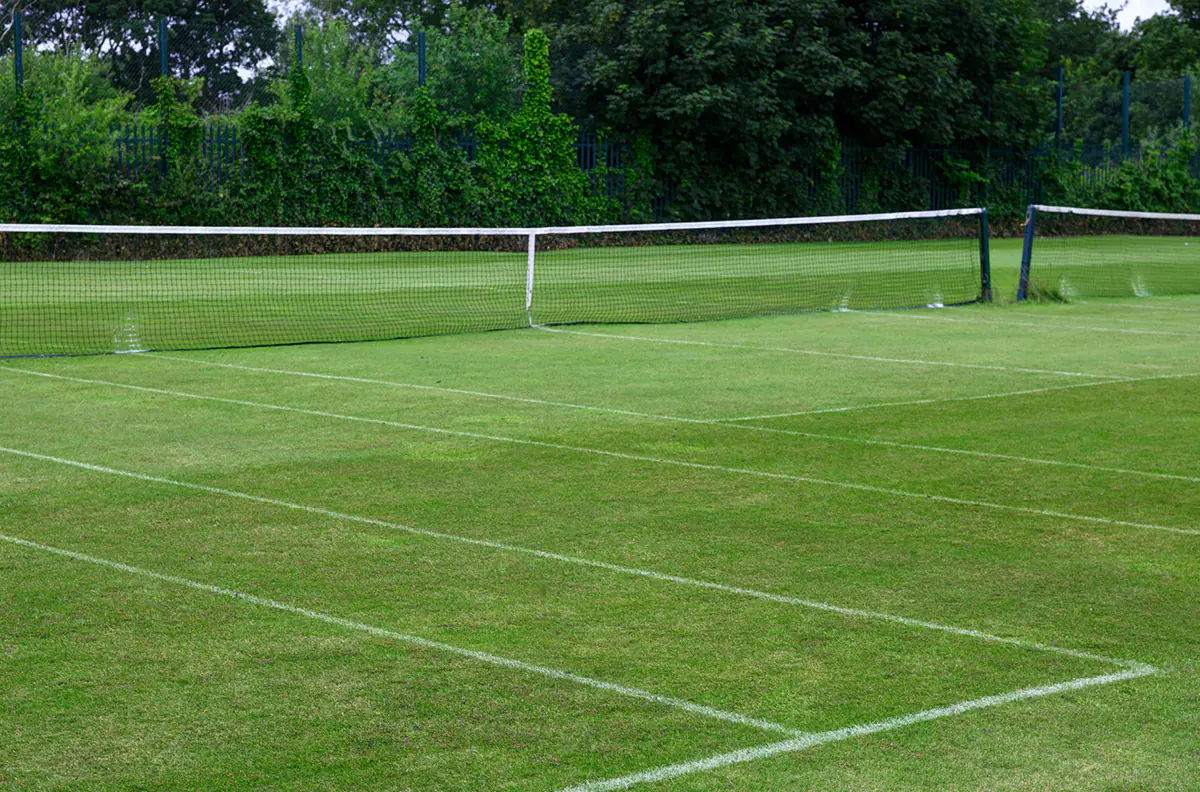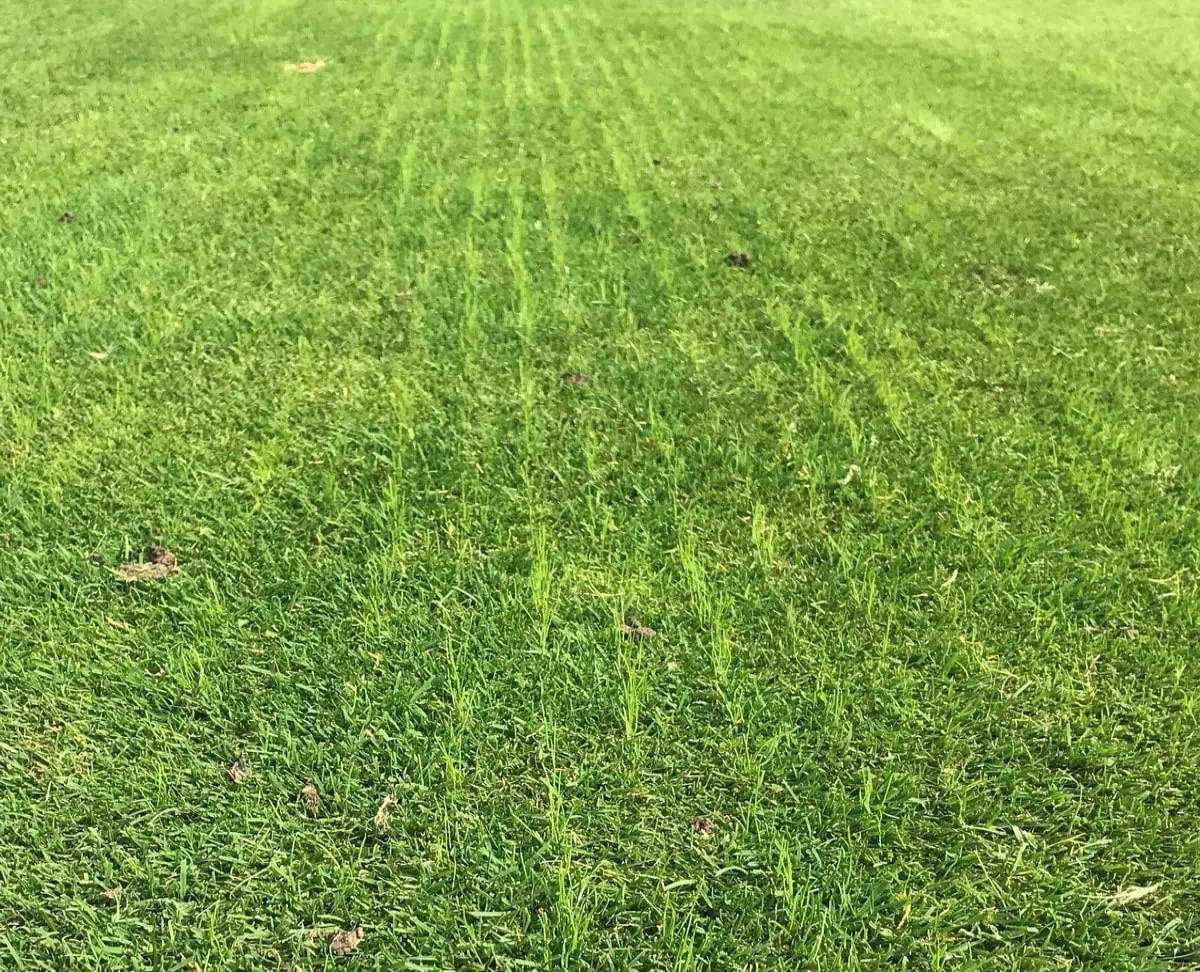Grass tennis court maintenance
Germinal Amenity’s Sandy Pentecost is an expert in grass tennis court maintenance. Sandy’s guide includes seasonal maintenance techniques to improve the quality of your tennis courts.

The key to a natural grass tennis court is a firm, even surface to provide the best playability in traction and ball bounce. Keeping these critical performance factors at the core of your lawn tennis court maintenance practice is achievable at all levels.
At the minimum, we recommend using a cylinder mower to reach the desired playing length.
Spring grass court maintenance
Maintaining grass tennis courts in early spring
Grass tennis court maintenance is essential in the spring to prepare for the season ahead. The cutting heights can be reduced to 15mm in early spring – once a week is ideal. In addition, clipping collection is a necessity and will help keep the courts free of any debris. It is also good practice to remove dew daily throughout the year to help prevent any threat of disease.
Tennis courts will benefit from a spring feed once soil temperatures are adequate. A good temperate would be approximately 11°C, where soil microbes are active enough to enable nitrogen conversion for plant uptake.
A spring feed like G4 will allow courts to build strength and increase density before the playing season begins. Light verti-cutting is recommended to control density and uneven growth and is more specific towards the opening of courts.
Pre-season rolling
Pre-season rolling is advised to increase firmness from mid-March onwards but only do this when conditions allow. If the conditions are too wet, avoid rolling.
A selective herbicide will kill unwanted weeds while keeping the surrounding grasses unharmed. Alternatively, you can use our G14 as a spring feed and a weed and moss treatment.
Sarrel rolling is encouraged to keep the surface open or else use other aeration equipment. Pencil tining or an Air2G2 are used at more advanced levels to provide the best return for water movement and airflow. All aeration must be carried out in the off-season, so make the best of the opportunities available.
Grass court maintenance in late spring
When preparing to open courts in late spring, the cutting height should be reduced to approximately 10mm. This height must be maintained throughout the playing season to provide a consistent surface.
Initial line marking should be carried out per the recommended court dimensions found on the Lawn Tennis Association website.
Summer grass tennis court maintenance
The cutting frequency will ideally increase to three times a week due to improved growth from warmer conditions. Techniques such as brushing or drag matting the courts before cutting are recommended to help stand the grass up.
Rolling is required to promote firmness and must be completed when appropriate.
A slow-release fertiliser is best throughout the season. Germinal’s Novatec premium will provide 5kg of nitrogen every month. The feed lasts for 12 weeks on a clay soil profile.
If you have spraying equipment, applying a liquid feed such as GL2 at 30L/ha over 21-day intervals is recommended. Liquid feeds allow closer control and affords a more reactive approach.
Marking out should be kept on top, particularly on baselines with more wear. Summer cutting heights should be maintained until the end of the playing season. Then, reduce the height to 5-10mm before renovating.
Autumn lawn tennis court maintenance
The autumn renovation aims to remove any fibre build-up in the soil profile using a scarifier or Graden machine.

Firstly, take a core sample, judge how much fibre needs to be removed and set the tine depth accordingly.
The next step is to select a grass seed mixture suitable to germinate quickly and provide a hard-wearing surface. Germinal’s A5 tennis grass seed contains ultrafine ryegrass species Cabrio and Escapade, offering root penetration and density.

Sow at 35g/m² using a broadcast fertiliser spreader, which will find its way into the scarification grooves once dragged in with the top dressing.
A loam needs to be selected in line with what has previously been used. It’s essential to match the clay content so that the material used keys into the existing surface. Apply this material at 3kg/m², and the compatible loam chosen should be drag matted or brushed into the surface.
A high-phosphorous fertiliser such as G12 should be applied to aid the establishment of new plants.
Once the seed has been established, regular mowing is encouraged to enable the new plants to tiller and thicken out. Mowing heights should be at 20mm – rotary mowing and collection of clippings are preferred.
Baseline areas may need further overseeding along with other areas that have struggled to develop. Nevertheless, it’s good to ensure total plant coverage going into winter.
Winter grass court maintenance
Maintaining a grass tennis court from November to February
Keeping the plant as healthy as possible during the winter months is paramount. A combination of cultural practices will help achieve this.
If the conditions are suitable, mowing can be carried out when required. However, the mowing height should be maintained at 20-25mm. It’s important to keep removing dew daily with a brush to help prevent disease outbreaks. Knock off worm casts with a swish cane and keep the surfaces clear of fallen leaves.
A high Iron fertiliser should be applied to protect plant health – our grass expert recommends the G14. Aerate with pencil tines to encourage air movement in the soil profile when possible.
Grass tennis court maintenance advice
Please contact our sports grass experts if you require lawn tennis court maintenance advice.


